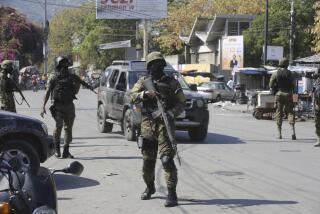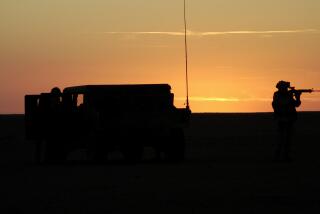THE SUNADY PROFILE : War Stories : The place: Saigon. The date: April 30, 1975. A moment in history brought a lifetime of memories for a Vietnamese civilian and a U.S. Marine. And for one Vet, it marked the beginning of a personal journey.
- Share via
Mike Sullivan
Seated at his kitchen table in San Juan Capistrano, retired Marine Master Sgt. Mike Sullivan examines an old black-and-white photograph.
It shows a 29-year-old Sullivan carrying an M-16 in one hand and a briefcase in the other as he scurries onto the deck of an aircraft carrier.
“We’re just stepping off the last helicopter out of Saigon,” Sullivan says. “That’s about 8:20 in the morning, on the 30th of April.”
It’s a date frozen in time, April 30, 1975--the day Saigon fell to the North Vietnamese army and the Vietnam War finally ended.
Sullivan and fellow Marine Security Guards at the American Embassy in Saigon earned their place in history that day as the last U.S. military personnel to leave Vietnam.
But Sullivan says they gave no thought to history during the final days of the war.
They were too busy living it: guarding the embassy compound from a mob of panicked South Vietnamese, destroying communications equipment, burning classified documents, and helping with the helicopter evacuation of an estimated 2,000 American and Vietnamese employees of the U.S. government and their families.
At one point, Operation Frequent Wind--as the Saigon to 7th Fleet shuttle was dubbed--appeared to have shut down. That left the last 11 Marine Guards stranded on the embassy rooftop, virtually forgotten until they were finally picked up nearly two hours later.
But for Sullivan, 49, who retired in 1988 after 21 years in the Marine Corps, the dramatic story of the fall of Saigon began more than five weeks earlier.
Just off work from his job as assistant to Master Sgt. John Valdez, the noncommissioned officer in charge of the Marine Security Guard at the embassy, Sullivan was relaxing with his wife, Camy, in their apartment when there was a knock at the door.
It was a friend, a retired South Vietnamese army sergeant major. Sullivan invited him in, but the man was in a hurry. He had stopped by for only one reason: to warn Sullivan that he had to get his wife out of the country. Fast.
“I said, ‘What’s wrong?’ ” Sullivan recalls. “This was the first time I ever saw the man look frantic. He said to me, ‘The North Vietnamese are going to overrun South Vietnam and take Saigon.’ ”
Sullivan’s first reaction was disbelief. Although the North had launched an offensive, he felt confident that the South Vietnamese army would “put up a good fight.” At the time, Saigon was peaceful.
But Sullivan knew that his friend was “plugged into the CIA” and was “definitely a man who had the knowledge to make that statement.”
“He and I spoke a little longer, and he gave me a feel for where (the North Vietnamese) were, how soon Da Nang would fall, how soon Nha Trang would fall and how very poorly the South Vietnamese army was ready for this.”
*
The next morning, Sullivan told Valdez what he had heard. Working on the assumption that his friend’s information was accurate, Sullivan recalls, “We began to decide what we were going to do for extraction points to get people out.”
When they presented their ideas to the State Department’s security officer at the embassy, a man who also was “pretty well plugged into the CIA,” he told them, “Gee, your source is good.”
The next day, Sullivan took his wife to the passport office to get her exit visa and booked her on a flight to Seattle, via Hong Kong.
After that, Sullivan says, he and Valdez spent most of their time planning for the evacuation and trying to “keep a lid on the feelings and fears” of the unseasoned younger Marine Guards.
By the morning of April 29, hundreds of Vietnamese who had worked for the U.S. government were congregating at the rear gate of the embassy compound. The Marine Guards were letting in only those who had a government ID card, along with immediate family members.
Initially, Tan Son Nhut Air Base on the outskirts of Saigon was to be the only evacuation point. But Saigon streets became so clogged that buses carrying evacuees from the embassy and other pickup points could not get there.
It was then decided to add a second evacuation site: the embassy compound.
Sometime after 1 p.m., a large tamarind tree in the embassy courtyard was cut down to make room for a landing zone.
By then, the scene outside the compound gate had grown chaotic. People were screaming to be let in. Many tried climbing the embassy wall but were repelled by the Marines. Some offered cash, gold and jewelry for space on one of the helicopters.
Although U.S. Ambassador Graham Martin had given the order to begin the helicopter evacuation of Saigon shortly before 11 a.m., delays prevented the first choppers from arriving at Tan Son Nhut until about 3 p.m.
About the same time, 130 infantry Marines were flown into the embassy courtyard to reinforce the Marine Guards on the walls, and the first load of refugees was taken out.
Landings of the evacuation helicopters at the embassy were sporadic at first. But by late afternoon the helicopters--CH-46 Sea Knights on the embassy roof and the larger CH-53s in the courtyard--were landing simultaneously about every 15 minutes.
During the early hours of the 30th, evacuation flights slowed dramatically. The pilots were fatigued, and many choppers were down for emergency maintenance.
Shortly before 5 a.m. the ambassador, under presidential order, was flown out of the embassy, followed a few minutes later by the last American officials. Then the Marines were ordered to pull back from the walls. Sullivan and the four other Marine Guards still in the courtyard walked slowly backward toward the embassy door.
When they were about 30 feet away, Sullivan ordered everyone to run. At their heels were about eight Vietnamese men. Before the Marines could close and secure the embassy’s two huge doors, several Vietnamese tried to force their way in. A fistfight broke out as the Marines pushed the men back and finally shut the doors.
About a dozen Marine Guards in the embassy foyer took the elevator to the sixth floor and onto the rooftop, where they joined scores of Marines waiting to be lifted out.
An exhausted Sullivan, without sleep for 35 hours, joined other Marines on the helipad. And there they sat and waited.
*
When it looked as though no more helicopters would be coming, Sullivan got on a field radio; he knew the command and control ship off the coast would be monitoring the airwaves. When there was no response, he kept calling every 15 minutes.
“I was relatively confident they knew where we were,” he says. But as time passed he grew more anxious. “Finally, the ship comes on the radio frequency and wants to know who I am and where I’m at and why I’m on this unauthorized frequency. . . .
“I said, ‘I want you to send one helicopter to the American embassy and just see who’s waiting.”
By about 6:15 a.m., several loads of Marines had been lifted off the rooftop, but 11 embassy Marine Guards remained.
“We were sitting there waiting for the last one to come in,” says Sullivan. “I thought, ‘They forgot us.’ Actually, they did forget us.”
Finally, a helicopter pilot answered Sullivan’s renewed radio calls.
“I told them there was 11 of us still on the embassy roof waiting to get off,” he says. “And finally here comes four gunships real low and real fast and a CH-46. The 46 lumbers in and sets down, and we jumped on board.”
After a delay, they lifted off at 7:58.
“Everyone was giving each other high fives because we were so happy to be gone,” Sullivan recalls. “There was no thought about history, there was no thought about the war being over and that we don’t ever have to play in this country again. . . .”
Sullivan sat back in his seat on the helicopter “and just closed my eyes and said a couple of prayers because I really thought we weren’t going to come out of that.”
More to Read
Sign up for Essential California
The most important California stories and recommendations in your inbox every morning.
You may occasionally receive promotional content from the Los Angeles Times.










